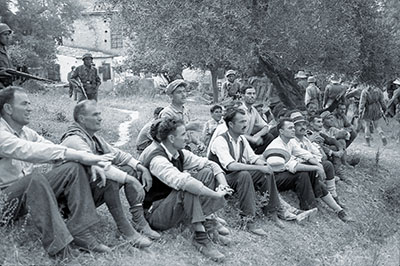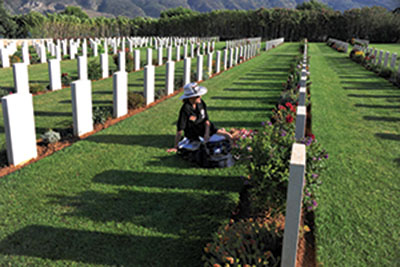I’M STANDING ON A SMALL HILL COVERED IN WILD THYME regularly pruned by feral goats that wander down from nearby mountains. Spread below, the scrubby olive-green expanse of Crete’s Maleme airfield stretches to the distant sea.
I drove to this rural hillside from Chania, a seaside town on the northwest hem of the largest of the Greek islands. Its harbor is home to a jumble of lively cafés that serve dishes cooked in local virgin olive oil. I am here to attend a three-day commemoration of the Battle of Crete, which began 75 years earlier on this very day—May 20. “This is Hill 107; from here our Allied troops shot down many planes,” says native-born Giorgos Milonakis, whose father was 10 years old when the battle started. Milonakis’s eyes glint in the midday sun as he squints down at the German War Cemetery, where the graves of thousands of enemy soldiers stud the surface.
Far below us, fields and olive groves slumber in the hot sun, much as they did that May morning in 1941 when the Nazis launched Operation Mercury, a massive airborne assault that dropped some 7,000 German paratroopers around Maleme and Chania. The success of the mission was vital to the Germans; whoever controlled Crete had easy access to the Suez Canal—the shortest route for conveying supplies to North Africa. German occupation of Crete would also prevent British bombers from flying from there to attack the Romanian oil fields that fueled the Nazi war machine.

The Battle of Crete had a number of significant firsts. It was the first large-scale German airborne offensive. It was also the first time the Allies had, thanks to intercepted Enigma transmissions, advance notice of a major German offensive—one the Allies failed to adequately exploit, but recognized as a heads-up for the future. And it was the first time a civilian population massively resisted a German advance.
The German chief of military intelligence, Admiral Wilhelm Canaris, had believed that the Cretans—renowned for their republican and anti-monarchist stance—would welcome their German liberators with open arms. Instead they met the paratroopers with fierce opposition. Armed with antique rifles, daggers, and even pitchforks, they took up arms alongside Allied troops from Greece, Britain, Australia, and New Zealand. As a result, the invasion of Crete took longer than Germany had expected. Though Allied troops began to retreat just a week later, Cretan resistance fighters continued their assault on enemy troops, forcing Hitler to send reinforcements.
The next day, I arrive at a flag-raising ceremony at Chania’s Firkas Fortress, a seventeenth-century stronghold located at the entrance of the city’s harbor. A handful of veterans, some in wheelchairs, watch as the ensigns of the four countries that helped defend Crete are slowly raised above the fortress walls.
To further preserve the memory of this event, the locals have created a Battle of Crete exhibit housed within the fortress. Amid ancient amphorae and remnants from 400 years ago, when the Republic of Venice colonized Crete, there are rooms full of battle memorabilia, including German parachutes, newspaper headlines, cigarette packets, and photos of resistance fighters. One of them shows a group of local men waiting to be executed. “The Germans murdered them for helping the Allies,” someone behind me murmurs.

Despite Crete’s strong resistance, Maleme airfield fell to the Germans on May 21 and, after failed attempts to retake it, Allied troops began retreating to the south coast for evacuation on May 27. The exhausted men withdrew over rocky ground while members of the New Zealand 28th (Maori) Battalion, along with Australian 2/7th Battalion’s C and D Companies, established a defensive line to buy time for the retreating soldiers.
Later in the day, I meet Marshall Cook, a Maori and member of the New Zealand Defense Force (NZDF), a military unit made up of settlers and Maoris—the indigenous people of New Zealand. Cook is here to pay his respects to a relative who, along with other troops in the defensive line, lost his life charging the Germans. “The 28th (Maori) Battalion stepped up and ripped into our traditional Haka war cry.” Cook tells me. “They used it to psych themselves up for the charge. They were up against some horrendous odds tearing off into the olive groves in face of the oncoming German attack.”
Following the ceremony, a drive through the warren of Chania’s backstreets takes me out to Souda Bay, a natural harbor just outside town and home to the British Commonwealth War Cemetery, where 1,500 servicemen who lost their lives in the battle are buried. Many of them are Maoris. There, Jack Rudolpf, a Maori cultural adviser to the NZDF, tells me that the warlike Maori felt—and still feel—at ease with the locals. “We owe them a lot of thanks,” he says, “because some of our soldiers who were left behind wouldn’t have made it home without them.”

Approximately 16,000 evacuated Allied troops eventually reached Egypt by ship. The majority of these embarked between May 28 and June 1 from the southern harbor of Sfakia, where I arrive after a two-hour drive the next day. Coasting along the curvy roads, I imagine how hard it must have been for the retreating men to hide from gunfire on these rocky hillsides.
More than 5,000 Allied troops and thousands of Greeks remained behind in Sfakia hiding in caves, but surviving for a time thanks to the help of Cretan villagers and resistance fighters—many of whom German troops later massacred.
Although German forces fought against a defiant populace during the entire Greek campaign of April to June 1941, resistance was strongest in Crete, where Germany took the most casualties. Out of about 22,000 German troops who fought to capture Crete—those in the initial paratroop assault and the several thousand mountain troops who later landed by sea—more than 4,500 Germans were killed. Nazi leadership deeply felt those losses and, for the remainder of the war, never attempted another large airborne operation.
Luftwaffe general Kurt Student, who headed the invasion, later wrote that Crete “conjures up bitter memories. I miscalculated when I proposed the operation and my mistakes caused not only the loss of very many paratroopers, whom I looked upon as my sons, but in the long run led to the demise of the German airborne arm I had created.”
The tiny fishing port of Sfakia looks much the same as it did in photos from 75 years ago. Seated in a café on the waterfront where I am surrounded by Crete’s starkly beautiful landscapes and proud people, it is easy to understand why they had fought so fiercely. ✯
This story was originally published in the January/February 2017 issue of World War II magazine. Subscribe here.





